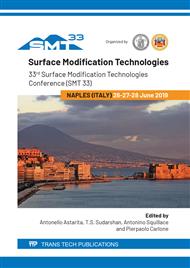[1]
K.K. Chao, C.S. Saba, Tribo-Evaluation of High Temperature Candidate Fluids in a Sliding TBOD, Bench Tester, Tribology Transactions. 38 (1995) 63-68.
DOI: 10.1080/10402009508983381
Google Scholar
[2]
D. Philippon, M.-I. De Barros-Bouchet, T. Le Mogne, O. Lerasle, A. Bouffet, J.-M. Martin, Role of nascent metallic surfaces on the tribochemistry of phosphite lubricant additives, Tribology International 44 (2011) 684–691.
DOI: 10.1016/j.triboint.2009.12.014
Google Scholar
[3]
V. Schettino, R. Bini, Molecules under extreme conditions: Chemical reactions at high pressure, Phys. Chem. Chem. Phys. 5 (2003) 1951–(1965).
DOI: 10.1039/b301381b
Google Scholar
[4]
W. Kauzmann, H. Eyring, The Viscous Flow of Large Molecules, J. Am. Chem. Soc. 62 (1940) 3113–3125.
DOI: 10.1021/ja01868a059
Google Scholar
[5]
A.K. Rasheed, M. Khalid, W. Rashmi, T.C.S.M. Gupta, A. Chan, Graphene based nanofluids and nanolubricants – Review of recent developments, Renewable and Sustainable Energy Reviews 63 (2016) 346–362.
DOI: 10.1016/j.rser.2016.04.072
Google Scholar
[6]
J. Lee, S. Cho, Y. Hwang, H.-J. Cho, C. Lee, Y. Choi, B.-C. Ku, H. Lee, B. Lee, D. Kim, S.H. Kim, Application of fullerene-added nano-oil for lubrication enhancement in friction surfaces, Tribology International 42 (2009) 440–447.
DOI: 10.1016/j.triboint.2008.08.003
Google Scholar
[7]
J. Padgurskas, R. Rukuiza, I. Prosyčevas, R. Kreivaitis, Tribological properties of lubricant additives of Fe, Cu and Co nanoparticles, Tribology International 60 (2013) 224–232.
DOI: 10.1016/j.triboint.2012.10.024
Google Scholar
[8]
A. Hernández Battez, R. González, J.L. Viesca, J.E. Fernández, J.M. Díaz Fernández, A. Machado, R. Chou, J. Riba, CuO, ZrO2 and ZnO nanoparticles as antiwear additive in oil lubricants, Wear 265 (2008) 422–428.
DOI: 10.1016/j.wear.2007.11.013
Google Scholar
[9]
M. Sarno, D. Spina, A. Senatore, One-step nanohybrid synthesis in waste cooking oil, for direct lower environmental impact and stable lubricant formulation, Tribology International 135 (2019) 355–367.
DOI: 10.1016/j.triboint.2019.03.025
Google Scholar
[10]
G. Liu, X. Li, B. Qin, D. Xing, Y. Guo, R. Fan, Investigation of the Mending Effect and Mechanism of Copper Nano-Particles on a Tribologically Stressed Surface, Tribology Letters 17 (2004) 961–966.
DOI: 10.1007/s11249-004-8109-6
Google Scholar
[11]
M.K.A. Ali, M.A. Abdelkareem, A. Elagouz, E. F, H. Xianjun, Mini review on the significance nano-lubricants in boundary lubrication regime, International Journal of Biosensors & Bioelectronics 2 (2017) 42-43.
DOI: 10.15406/ijbsbe.2017.02.00014
Google Scholar
[12]
M. Gulzar, H.H. Masjuki, M.A. Kalam, M. Varman, N.W.M. Zulkifli, R.A. Mufti, R. Zahid, Tribological performance of nanoparticles as lubricating oil additives, J Nanopart Res. 18 (2016) 223.
DOI: 10.1007/s11051-016-3537-4
Google Scholar
[13]
W. Dai, B. Kheireddin, H. Gao, H. Liang, Roles of nanoparticles in oil lubrication, Tribology International 102 (2016) 88–98.
DOI: 10.1016/j.triboint.2016.05.020
Google Scholar
[14]
V.W. Wong, S.C. Tung, Overview of automotive engine friction and reduction trends–Effects of surface, material, and lubricant-additive technologies, Friction. 4 (2016) 1–28.
DOI: 10.1007/s40544-016-0107-9
Google Scholar
[15]
T.S. Omonov, E. Kharraz, J.M. Curtis, The epoxidation of canola oil and its derivatives, RSC Adv. 6 (2016) 92874–92886.
DOI: 10.1039/c6ra17732h
Google Scholar
[16]
S. Dinda, A.V. Patwardhan, V.V. Goud, N.C. Pradhan, Epoxidation of cottonseed oil by aqueous hydrogen peroxide catalysed by liquid inorganic acids, Bioresource Technology 99 (2008) 3737–3744.
DOI: 10.1016/j.biortech.2007.07.015
Google Scholar
[17]
D.C. Panadare, V.K. Rathod*, Applications of Waste Cooking Oil Other Than Biodiesel: A Review, Iranian Journal of Chemical Engineering(IJChE) 12 (2015) 55–76.
Google Scholar
[18]
A. Campanella, E. Rustoy, A. Baldessari, M.A. Baltanás, Lubricants from chemically modified vegetable oils, Bioresource Technology 101 (2010) 245–254.
DOI: 10.1016/j.biortech.2009.08.035
Google Scholar
[19]
A.H. Suzuki, B.G. Botelho, L.S. Oliveira, A.S. Franca, Sustainable synthesis of epoxidized waste cooking oil and its application as a plasticizer for polyvinyl chloride films, European Polymer Journal 99 (2018) 142–149.
DOI: 10.1016/j.eurpolymj.2017.12.014
Google Scholar
[20]
F.C. Fernandes, K. Kirwan, D. Lehane, S.R. Coles, Epoxy resin blends and composites from waste vegetable oil, European Polymer Journal 89 (2017) 449–460.
DOI: 10.1016/j.eurpolymj.2017.02.005
Google Scholar
[21]
M. Sarno, E. Ponticorvo, D. Scarpa, PtRh and PtRh/MoS2 nano-electrocatalysts for methanol oxidation and hydrogen evolution reactions, Chemical Engineering Journal (2018) in press.
DOI: 10.1016/j.cej.2018.12.060
Google Scholar
[22]
M. Sarno, M. Iuliano, Highly active and stable Fe3O4/Au nanoparticles supporting lipase catalyst for biodiesel production from waste tomato, Applied Surface Science. 474 (2019) 135–146.
DOI: 10.1016/j.apsusc.2018.04.060
Google Scholar


